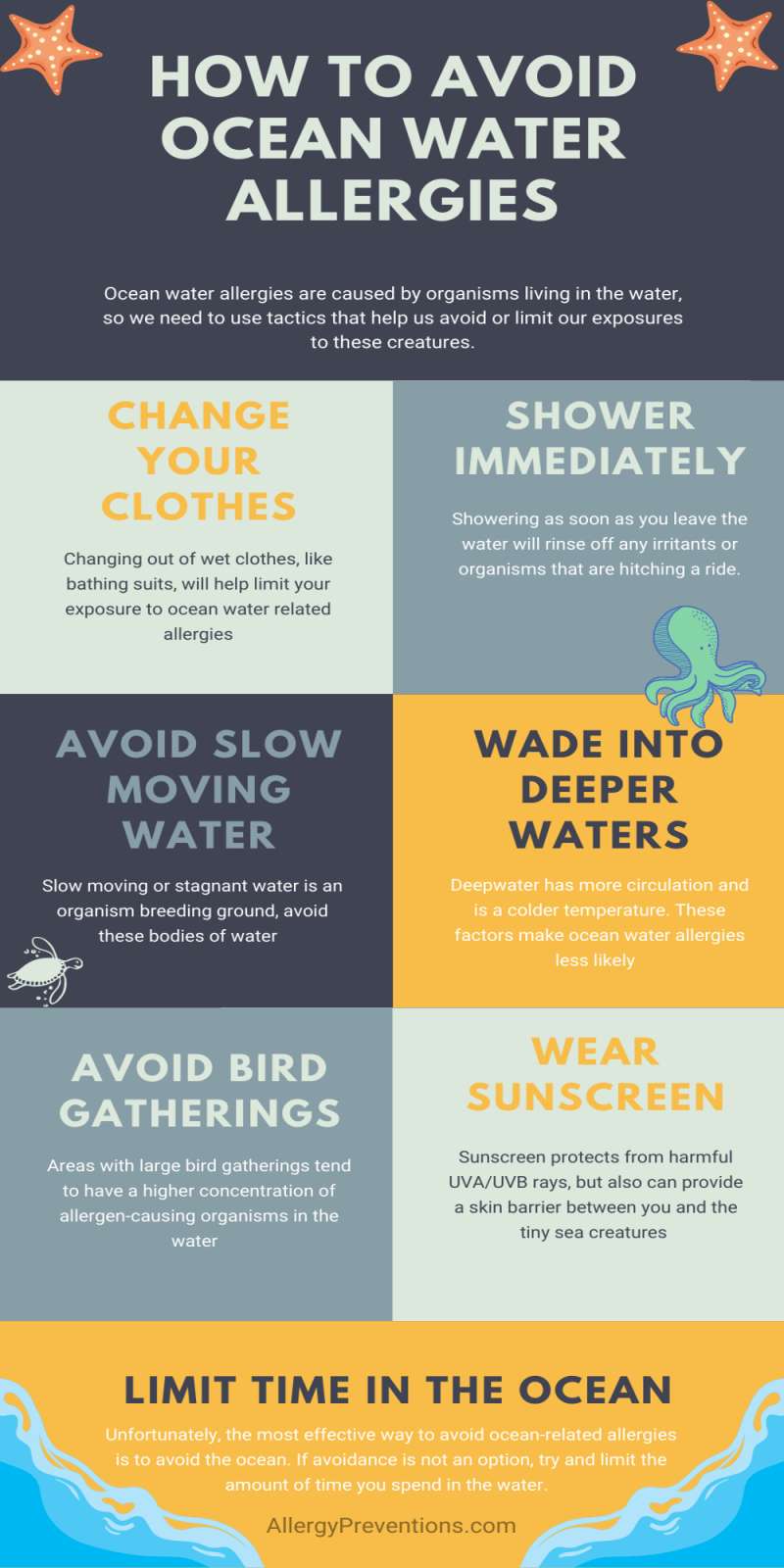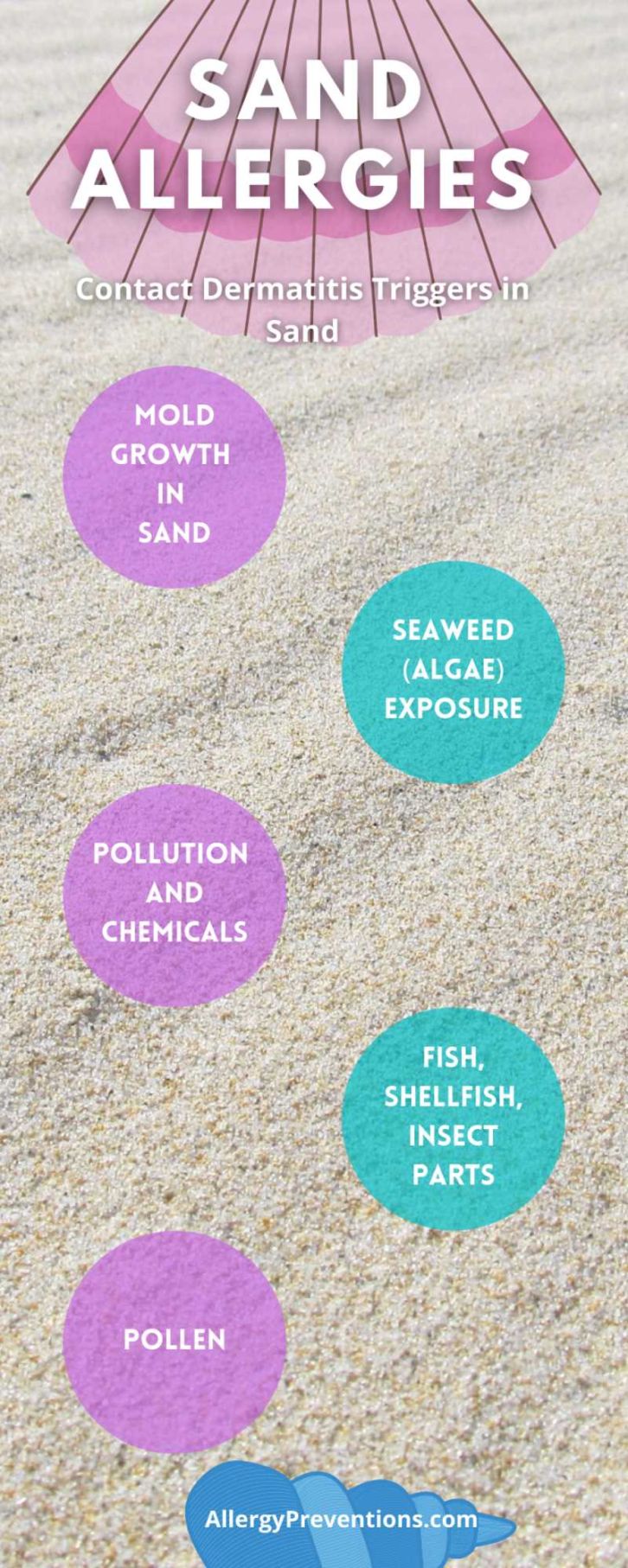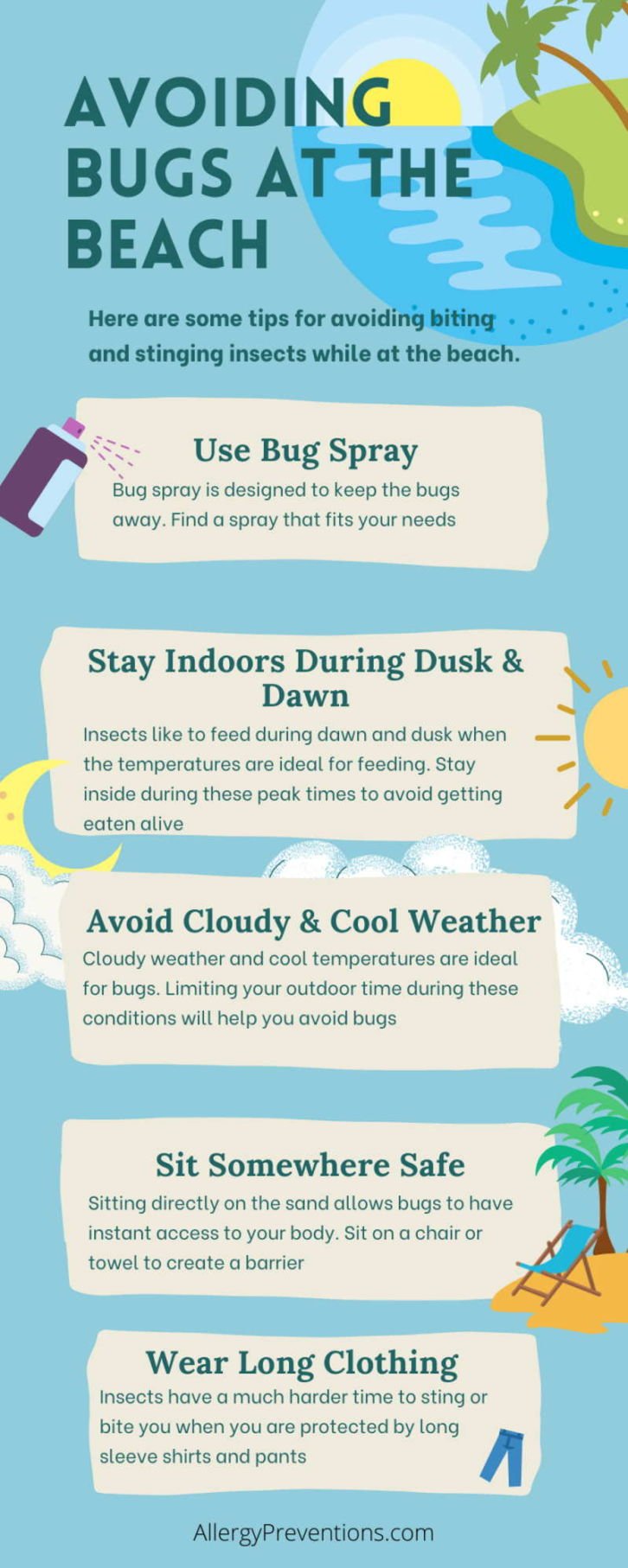You have finally got yourself to the beach for your summer vacation, but you begin to experience allergies. This is an allergy sufferer’s nightmare! Get ready for the most in-depth list of potential triggers to help you solve the mystery of why your allergies are worse at the beach.

As an Amazon Associate, I earn from qualifying purchases
Table of Contents
Beach Allergies

Beach allergies, also known as beach-related allergies or coastal allergies, refer to allergic reactions that occur when individuals are exposed to allergens commonly found at the beach or coastal areas. Although mostly related to summer allergies, beach allergies can happen at any time of year.
These allergies can be triggered by various substances present in the beach environment, such as pollen, mold spores, insects, seaweed, and sea creatures like jellyfish and shellfish.
Most Common Beach Allergy Symptoms
You may be suffering from allergies at the beach if you have one or more of these symptoms:
- Congestion
- Hives
- Itchy ears and/or throat
- Itchy eyes and/or watery eyes
- Oral Allergy Syndrome (OAS)
- Post-Nasal Drip (can lead to cough)
- Rash
- Sinus pain or pressure
- Sneezing
These are not necessarily all the symptoms of allergies, but they are more common than others. Unfortunately, these symptoms can be part of non-allergy-related conditions like a cold.
Common Beach Allergy Triggers
Allergy triggers at the beach sometimes show up in a non-traditional manner due to the unique climate, as well as activities you might only do at the ocean. Let’s go over these triggers and how they are disguising themselves at the beach.
Sun Allergy

A sun allergy is described as any irrational immune system response to sunlight. This condition affects up to 15% of the U.S. Population. A sun allergy, also known as photosensitivity or sun sensitivity, is a condition in which the skin reacts abnormally to exposure to sunlight or certain types of artificial light. It is an immune system reaction that occurs when the skin is exposed to ultraviolet (UV) radiation from the sun.
Avoiding sun allergies
Avoiding the sun is one way to avoid a sun allergy, but not cool when you are at the beach. Alternatively, applying high-quality sunscreen to help control sun allergy symptoms may help.
Allergic to Your Sunscreen

You may experience an allergy or reaction to the sunscreen you are using. According to the Australian Cancer Council, there are two types of contact dermatitis: irritant and allergic. Both of which can cause an allergic reaction at the beach.
Irritant Contact Dermatitis
Irritant contact dermatitis is a reaction after applying sunscreen that causes irritation where the sunscreen was applied. Typical reasons for irritation to occur from sunscreen are if the sunscreen contains heavy fragrances, or if you are putting the sunscreen on already irritated skin.
Allergic Contact Dermatitis
Allergic contact dermatitis is a less common type of dermatitis caused by an allergy to one of the ingredients in your sunscreen. For example, if you have a coconut allergy, and one of the ingredients of the sunscreen is coconut oil, you may develop an allergic contact dermatitis reaction.
Avoiding Sunscreen Allergy

Sunscreen benefits outweigh the risks of not wearing sunscreen (in my opinion, and science). Many major brand sunscreens have loads of chemicals that can cause an allergic reaction and irritate the skin.
Choose a sunscreen that fits your needs, blocks UVA and UVB rays, but also contains less harmful ingredients. I found this sunscreen on Amazon which has an EWG rating of 1 (that’s good) meaning it’s not full of harmful ingredients!
This Badger – SPF 30 Clear Zinc Sunscreen Cream, is unscented and safe for the whole family, check it out.
You can pick up this sunscreen on Amazon which might be worth a try if you have a sunscreen allergy.
Ocean Water Allergy (Swimmer’s Itch, Seabather’s Eruption, Seaweed Dermatitis)

Ocean water allergy is a generalized term to describe waterborne allergic and inflammatory reactions. These reactions are typically caused by one of the following: Swimmer’s Itch (Swimmer’s Rash), Seabather’s Eruption, or Toxic Seaweed Dermatitis.
Swimmer’s Itch

The CDC explains that Swimmer’s Itch (cercarial dermatitis) is an allergic reaction on the skin caused by microscopic parasites in the water. The parasites in their larval state, burrow under the skin which may spark an allergic reaction in the form of a rash.
The condition causes an itchy, red rash on the skin. Swimmer’s itch can be treated with over-the-counter medications, and the rash will usually go away within a few days.
Seabather’s Eruption

Dermatology Advisor lets us know that Seabather’s Eruption is caused by cnidarian larvae (jellyfish, sea anemones, hydra, and corals) becoming trapped on the skin because of clothing (i.e. bathing suits, dive gear) or skin folds (i.e. underarms, toes, midsection).
The symptoms can range from mild to life-threatening and include redness, itching, swelling, blisters, and welts. There is no cure for Seabather’s eruption, so it is important to take precautions to avoid it.
Common locations in the U.S. where Seabather’s eruption is found include Florida and the Long Island area.
Toxic Seaweed Dermatitis (Lyngbya dermatitis)

The most common type of toxic seaweed dermatitis is caused by a type of red algae known as Phaeophyceae. This type of algae can produce toxins that can cause skin irritation, rashes, and blisters.
Other types of toxic seaweed can also cause dermatitis, including the brown algae laminaria and the green algae Ulva. These types of algae can produce irritating compounds that can cause skin problems such as redness, itching, and swelling.
The International Journal of Dermatology reports that toxic seaweed dermatitis that is caused by blue-green alga (cyanobacterium) is found in temperate/tropical waters around the world.
Avoiding Ocean Water Allergies

These ocean water allergies are caused by organisms living in the water, so we need to use tactics that help us avoid or limit our exposure to these creatures. Here are a few tips to avoid allergies related to seawater:
- Avoid slow-moving waters like tide pools or stagnant areas
- Avoid the ocean (not Ideal, but effective)
- Avoid the water where there are large gatherings of birds
- Change out of wet clothes and bathing suits
- Shower or rinse immediately after leaving the water
- Swim a little deeper (safely), the cooler waters help
- Use waterproof sunscreen to create a skin barrier
Sand Allergy

Did you know that sand allergies are a real thing? The tiny particles of sand that get into your eyes, nose, and mouth can cause a range of allergic reactions. Symptoms can include itchy eyes, sneezing, a runny nose, and even asthma.

It is extremely rare to be allergic to sand, but it is possible. A more likely cause of a sand allergy is contact dermatitis from an element in the sand. Here are some examples:
- Mold growth (consistently wet sand)
- Seaweed (Algae)
- Pollution/chemicals
- Fish/Shellfish/Insect parts
- Pollen
Avoiding Sand Allergies
Avoiding sand-related allergies can be difficult! Of course, avoiding the sand is the most effective way to avoid contact dermatitis from the sand. But that can be near impossible when you are literally at the beach. Here are some additional tips:
- Avoid sand
- Keep a bottle of water with you to rinse away sand
- Limit playtime in the sand
- Shower Immediately after leaving the beach
- Visit beaches that have minimal pollution
- Wear sunglasses
Insect Stings and Bites

Insect stings and bites are common triggers for allergy symptoms when visiting the beach. Here are the top stinging and biting insects you may encounter.
Sand Flies
Sandflies (sand flies)are small biting flies that are found worldwide. The female sandflies consume a blood meal to develop their eggs. Sometimes that blood meal comes from us humans who are trying to enjoy the beach.
Only female sand flies bite, and it’s a painful bite. The bites can cause allergy-like skin reactions, inflammation of the skin, and even transmit certain diseases.
Sand Fleas
The term “sand flea” is a blanket term for small amphipods and crustaceans that you would find at the beach that hops like a flea. They are not fleas. Sand fleas are also known by the names: beach fleas, sand hoppers, sand mites, or beach hoppers.
According to the CDC, the species to look out for is the chigoe flea (Tunga penetrans) which is also called a jigger, nigua, chica, pico, pique, or suthi.
The chigoe flea is known for clawing into the skin (typically human feet) and latching on with their mouths. This burrowing causes inflammation and lesions on your feet.
Bloodworms
Bloodworms like to live in the sediment of the sea, and low tide pools. Of course, the sea and low tide pools might be where you are hanging out at the beach. Bloodworms tend to stick to themselves and don’t usually bother anyone.
The Washington State Department of Ecology posted an article that states “They (bloodworms) don’t usually harm humans intentionally, but if you did happen to put your finger near the worm’s mouth, you could end up with a minor bee-sting-like bite.”
For most individuals, this shouldn’t be a problem. But for others, it can cause an allergic reaction, that may become severe, similar to a bee sting.
Mosquitoes
Mosquitoes might not be your first thought as an insect that bites you at the beach. But it definitely can happen.
Usually, the higher winds help mitigate your mosquito exposure, but as you move inland to your camping area, or out of high wind areas, you are at a greater risk for mosquito bites. Like the sand flies, only female mosquitoes bite.
If you usually suffer from an allergic reaction to mosquito bites, the mosquitoes at the beach will probably give you the same allergic response.
Avoiding Insect Bites and Stings at the Beach

There are a few things you can do to mitigate being bit at the beach. Avoiding bites and stings while at the beach makes for a better experience for everyone. Here are some tips:
- Avoid going to the beach during cloud cover & cooler temperatures
- Limit outdoor activities during dawn and dusk
- Sit on a chair or blanket, not directly on the sand
- Use bug spray
- Wear long clothing
Seasonal Allergies
Seasonal allergies can be a major reason for your allergies to be worse at the beach, but the pesky allergen might be harder to find in this environment. Here are some unique areas allergens may be hiding that you might not have been aware of while at the beach.
Pet Dander

A dander allergy can be worse at the beach, not necessarily the ocean or sand, but where you are staying. If you are staying the night in a hotel or vacation rental, there might still be pet dander from the previous tenants.
Additionally, if you rented or borrowed a tent, sleeping bags, etc. and pets were hanging out near that equipment, this too could be the source of a pet dander allergy flare-up at the beach.
Avoiding Pet Dander at the Beach
- Avoid borrowing equipment from friends with pets
- Bring your personal pillow
- Refrain from using hard-to-clean items like sleeping bags and couches
- Stay at a location that doesn’t allow pets
- Steer clear of carpeted rooms
Molds

Mold exists in areas of high moisture, the beach and surrounding areas are typically humid, which mold loves. At the beach, you may be exposed inside buildings (stores, hotels, houses, cabins, campers) as well as outside in consistently damp areas like sand.
Avoiding Mold Allergies At The Beach
- Limit exposure to sand in moist and stagnant areas
- Run a dehumidifier
- Use a HEPA Air Purifier
- Visually inspect your hotel or camper for signs of mold
Grasses

Grass at the beach is crucial for controlling beach erosion and keeping sand dunes healthy. Unfortunately, these grasses can make our allergies worse at the beach. In combination with the grasses at the beach, high winds can spread the grass pollen as well.
Avoiding Grass Allergies at the Beach
- Avoid walking in the beach grasses
- Limit outdoor time when pollen counts are high
- Shower when you are done going outside
- Wear a mask
Dust Mites

Dust mites are little (microscopic) arthropods that love our skin cells, and thrive in high-humidity environments…like the beach… You might be running into dust mites in your camper, hotel, motel, or rental property.
Dust mites like to hide out in areas where we hang out (and lose skin cells) like the couch, bed, rugs, carpet, and stuffed animals.
Avoiding Dust Mite Allergies at the Beach
- Clean & Dust
- Run a dehumidifier
- Use a HEPA Air Filter
- Wash bedding often
- When staying at a hotel or rental property, ensure they have a mattress protector on
Trees

Tree allergies at the beach? Yes, you can still experience tree allergies at the beach, even if there are no trees nearby. Studies have shown that tree pollen can travel miles depending on wind direction, humidity, and temperature. The tree pollen you are allergic to may have blown toward you at the beach.
Barbecue or Campfire Smoke

Related to tree pollen allergies, the wood or coals you are burning might be the reason that your symptoms are worse at the beach. BBQ coals are not necessarily made of coal that you put in your fireplace but are usually comprised of wood products like sawdust and wood chips.
Campfire wood is made of trees and it could be the trees you are allergic to, just like the coals for your grill. Depending on your tree allergy, your barbecue or campfire can be the cause of making your allergies worse at the beach.
Avoiding Tree Allergies at the Beach
- Avoid campfires
- Avoid Charcoal Grills/smoke
- Run an air filter indoors
- Shower when you go inside for the night
- Wear a mask
Shellfish and Fish Allergies

A fish or shellfish allergy can flare up when consuming the allergen. Coastal restaurants serve up fish and shellfish, and if there is cross-contamination going on in the kitchen you may spark your food allergy.
Some individuals have such a strong allergy to shellfish that being near the food when it’s cooked (smoke and steam) can begin to experience symptoms.
Additionally, there are some documented cases of contact dermatitis from handling shellfish while at the beach (without consuming).
Avoiding Shellfish/Fish Allergies at The Beach
- Avoid playing with sea creatures you find
- Be cautious with seafood restaurants (Cross-contamination/airborne exposure)
- Limit sand exposure
- Shower immediately after your trip to the beach
Beach Allergies Frequently Asked Questions (FAQs)
Can the beach make allergies better?
Yes and No. For some individuals, the beach provides an allergy-free zone as the ocean breeze keeps pollen inland.
Does living near the ocean help with allergies?
Maybe. Living near the ocean can help with allergies, it just depends on what you are allergic to.
Why do I get a stuffy nose at the beach?
A stuffy nose at the beach can be caused by the following:
– Illness like a cold or flu
– Allergies
– Irritation from smoke or allergens
– Chemical exposure (fumes)
– Cold weather
Can the beach trigger allergies?
Yes. The beach can trigger allergies like sun, sand, and ocean allergies, which are different from typical seasonal allergies.
What allergens are at the beach?
The allergens that are typically found at a beach are seasonal (pollens, dust, grasses, weeds, trees), food, sun, ocean, and sand.
Can you get allergies from the ocean?
Yes. Ocean water has flora and fauna inside that can cause allergic reactions.
Is there pollen at the beach causing seasonal allergies?
Yes. The beach has a diverse population of different grasses, weeds, and trees, all of which produce pollen.
What climate is best for allergies?
The best climate for allergies would be the Polar climate. The AAFA has listed 10 “Better Than Average” places to live with seasonal allergies for those who don’t want to move to Antarctica.
Why do I have sinus allergies at the beach?
Sinus allergies and irritation at the beach can be caused by dust mites, pollen, dander, smoke, seawater in the nose, chlorine in the nose, mold, or even illness.
Why do I get a skin rash after going to the beach?
After going to the beach, a skin rash can be caused by: Sun, sunscreen, irritation from sand, ocean water exposure, pollen/mold airborne, and in the sand.
Final Thoughts
There are many different factors to consider when trying to figure out why your allergies are worse at the beach including the sun, sand, and ocean, which are the whole reason you have gone to the beach.
Hopefully, this breakdown has helped identify the cause of your allergy symptoms and how to avoid triggers that can make symptoms worse.
